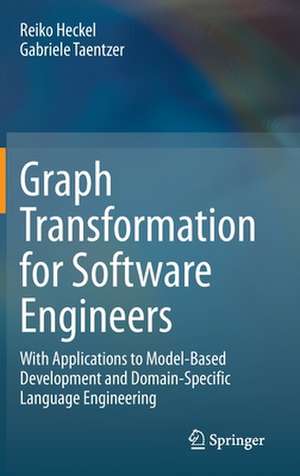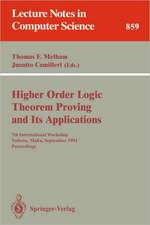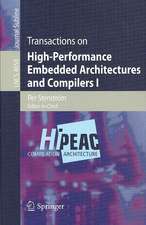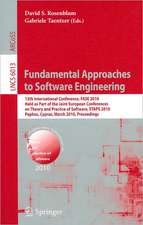Graph Transformation for Software Engineers: With Applications to Model-Based Development and Domain-Specific Language Engineering
Autor Reiko Heckel, Gabriele Taentzeren Limba Engleză Hardback – 14 mai 2020
The first part of the book presents the fundamentals in a precise, yet largely informal way. Besides serving as prerequisite for describing the applications in the second part, it also provides a comprehensive and systematic survey of the concepts, notations and techniques of graph transformation. The second part presents and discusses a range of applications to both model-based software engineering and domain-specific language engineering. The variety of these applications demonstrates how broadly graphs and graph transformations can be used to model, analyse and implement complex software systems and languages.
This is the first textbook that explains the most commonly used concepts, notations, techniques and applications of graph transformation without focusing on one particularmathematical representation or implementation approach. Emphasising the research and engineering methodologies used, it will be a valuable resource for graduate students, practitioners and researchers in software engineering, foundations of programming and formal methods.
| Toate formatele și edițiile | Preț | Express |
|---|---|---|
| Paperback (1) | 419.58 lei 6-8 săpt. | |
| Springer International Publishing – 14 mai 2021 | 419.58 lei 6-8 săpt. | |
| Hardback (1) | 596.63 lei 6-8 săpt. | |
| Springer International Publishing – 14 mai 2020 | 596.63 lei 6-8 săpt. |
Preț: 596.63 lei
Preț vechi: 745.79 lei
-20% Nou
Puncte Express: 895
Preț estimativ în valută:
114.16€ • 119.21$ • 94.27£
114.16€ • 119.21$ • 94.27£
Carte tipărită la comandă
Livrare economică 15-29 aprilie
Preluare comenzi: 021 569.72.76
Specificații
ISBN-13: 9783030439156
ISBN-10: 3030439151
Pagini: 309
Ilustrații: XX, 309 p. 168 illus., 91 illus. in color.
Dimensiuni: 155 x 235 x 25 mm
Greutate: 0.64 kg
Ediția:1st ed. 2020
Editura: Springer International Publishing
Colecția Springer
Locul publicării:Cham, Switzerland
ISBN-10: 3030439151
Pagini: 309
Ilustrații: XX, 309 p. 168 illus., 91 illus. in color.
Dimensiuni: 155 x 235 x 25 mm
Greutate: 0.64 kg
Ediția:1st ed. 2020
Editura: Springer International Publishing
Colecția Springer
Locul publicării:Cham, Switzerland
Cuprins
Part I, Graph Transformation.- Graphs for Modeling and Specification.- Graph Transformation Concepts.- Beyond Individual Rules: Usage Scenarios and Control Structures.- Analysis and Improvement of Graph Transformation Systems.- Part II, Graph Transformation in Software Engineering.- Detecting Inconsistent Requirements in a Use Case-Driven Approach.- Service Specification and Matching.- Model-Based Testing.- Reverse Engineering: Inferring Visual Contracts from Java Programs.- Stochastic Analysis of Dynamic Software Architectures.- Advanced Modeling Language Definition: Integrating Meta-modeling with Graph Transformation.- Improving Models and Understanding Model Changes.- Translating and Synchronizing Models.
Notă biografică
Prof. Dr.-Ing. Reiko Heckel is a member of the School of Informatics at the University of Leicester. Prof. Dr.-Ing. Gabriele Taentzer is a member of the Faculty of Mathematics and Computer Science at Philipps-Universität Marburg. The authors' research is in Graph Transformation, its foundations and applications to System Modelling and Analysis, Model-Based Software Development and Language Engineering.
Textul de pe ultima copertă
This book is an introduction to graph transformation as a foundation to model-based software engineering at the level of both individual systems and domain-specific modelling languages.
The first part of the book presents the fundamentals in a precise, yet largely informal way. Besides serving as prerequisite for describing the applications in the second part, it also provides a comprehensive and systematic survey of the concepts, notations and techniques of graph transformation. The second part presents and discusses a range of applications to both model-based software engineering and domain-specific language engineering. The variety of these applications demonstrates how broadly graphs and graph transformations can be used to model, analyse and implement complex software systems and languages.
This is the first textbook that explains the most commonly used concepts, notations, techniques and applications of graph transformation without focusing on one particular mathematical representation or implementation approach. Emphasising the research and engineering methodologies used, it will be a valuable resource for graduate students, practitioners and researchers in software engineering, foundations of programming and formal methods.
The first part of the book presents the fundamentals in a precise, yet largely informal way. Besides serving as prerequisite for describing the applications in the second part, it also provides a comprehensive and systematic survey of the concepts, notations and techniques of graph transformation. The second part presents and discusses a range of applications to both model-based software engineering and domain-specific language engineering. The variety of these applications demonstrates how broadly graphs and graph transformations can be used to model, analyse and implement complex software systems and languages.
This is the first textbook that explains the most commonly used concepts, notations, techniques and applications of graph transformation without focusing on one particular mathematical representation or implementation approach. Emphasising the research and engineering methodologies used, it will be a valuable resource for graduate students, practitioners and researchers in software engineering, foundations of programming and formal methods.
Caracteristici
Introduces graph transformation as a fundamental tool to enable model-based development Addresses both the fundamental concepts and the techniques Useful for graduate students in the areas of software engineering and foundations of programming, and practitioners and researchers in these domains























